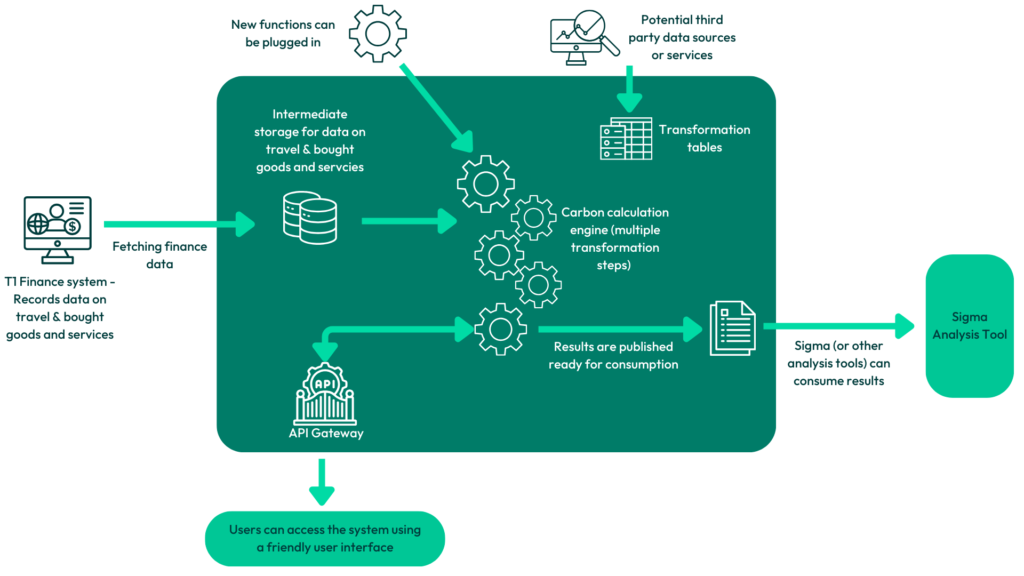The University’s Strategy 2030 is all about being greener, healthier, and fairer and leading meaningful action against the ecological crisis and climate emergency. This combined with our commitment to achieving Net Zero by 2030 means that we need to find ways to measure and reduce our carbon footprint. Digital is a key enabler of the University’s strategy and so the University’s Digital team are using agile ways of working to develop a carbon accounting tool to help the organisation to achieve its’ strategic goals.
Read this blog to learn what carbon accounting is and how we are delivering it.
What is Carbon Accounting?
An organisation’s carbon footprint is an indicator of the total amount of greenhouse gases emitted as a result of the organisation’s activities. Carbon accounting is the measurement and analysis of an organisations carbon footprint in order to understand which areas of activity are having the largest impact. This the first step in developing and implementing an effective decarbonisation strategy. The University is committed to a Net Zero target by 2030 and is leading on taking action and developing a best-in-class Carbon Accounting System.
How is carbon accounting done?

The University’s Sustainability Team are tasked with the measurement and analysis of UoE’s carbon footprint. The technology and practice are developing and are wide ranging, dealing with all UoE activities including energy, water, waste and investments. Phase one of this work will focus on our biggest greenhouse gas emissions categories: Travel and Bought Goods and Services, which will be determined by processing our finance system data to translate these activities into resultant greenhouse gas emissions. This data will then be dropped into a data warehouse where it can be analysed… enter the carbon calculator.
What is a carbon calculator?
This is the engine that extracts raw data from existing systems – initially the UoE finance system – and applies translations and calculations to interpret this data and feed the Sigma Analysis Tool. Previously these calculations were performed manually using a set of spreadsheets which was time consuming and took resource away from analysis that could inform decision. In line with our digital strategy, we identified an opportunity to automate this process to increase efficiency and enable people to get stuff done, while also providing opportunity to the University to generate more value and maximise our reputation.
Key components of the automated engine include:
- Automatic/scheduled data retrieval, which fetches purchasing and travel data from the finance system and places it in an intermediate store.
- The Calculation Engine itself which transforms this data based on rules and transformation tables.
- Provides an opportunity to feed supplier-specific data and external datasets into our carbon accounting behaviours, greatly improving accuracy.
- Results publication, which passes the results to the Sigma Analysis Tool for the Sustainability team to analyse the results and inform strategic direction, ensuring efforts target high-impact areas as a priority.

The above diagram shows that we can plug in new transformations or replace and update existing transformations, allowing the engine to adapt and grow. There is also the potential for automatically fetching transformation data directly from third parties.
What’s next for carbon accounting?
The immediate next steps for the platform involve extending the Application Programming Interface (API), enabling automation of parts of the process, and providing a user interface. We are also working closely with the Sustainability Team on the next steps for the platform.
In the future, iterations of the platform will include broadening the scope of data connections to cover all six primary emissions categories, including Energy, Water, Waste and Investments. Universities have a very broad range of activities contributing to their carbon footprint, including education services, research activity, commercial enterprises and residential facilities. Isolating these strands of activity may also provide insights for industry, offering data for situational modelling and strategy implementation to those who do not yet have a comprehensive carbon accounting system at their fingertips – this work is really exciting and could provide the University with lots of value in the future.
To learn more about how we are delivering a carbon calculator using agile ways of working and agile thinking, read this blog post.
– Written by Paul Durdin, Technical Analyst for Digital
To learn more about the Digital team at the University of Exeter take a look at our website here and our other blog posts here.

